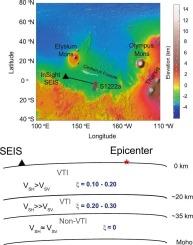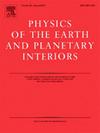火星低地地壳的地震各向异性分层
IF 1.9
3区 地球科学
Q2 GEOCHEMISTRY & GEOPHYSICS
引用次数: 0
摘要
迄今为止在火星上探测到的最大地震事件发生在2022年5月4日,可能就在半球形二分法的北面,着陆点的东面,Cerberus Fossae的南面。这一事件的独特之处在于它同时产生了洛夫波和瑞利波,包括基本波和更高波,这为我们提供了一个难得的机会来确定火星上是否存在地震径向各向异性。我们进行了非线性波形建模,并使用小生境遗传算法找到可接受的速度模型。我们的分析表明,在前40 km范围内,地震各向异性是必要的,地震波传播的快速方向为水平方向,与以往仅基于基模面波群速度频散的结果相似。我们的新模型显示了不同程度的各向异性分层。我们发现各向异性参数ξ = 1.0-1.2在5 ~ 20 km深度,ξ = 1.2-1.3在25 ~ 30 km深度。在35 km以下未发现明显的各向异性。虽然各向异性的起源仍在争论中,但它是具有垂直对称轴的介质的特征,可能是岩浆事件和撞击的结果。我们认为,各向异性分层反映了火星地壳形成历史的不同阶段。本文章由计算机程序翻译,如有差异,请以英文原文为准。

Seismic anisotropy layering in the Martian lowlands crust
The largest seismic event ever detected on Mars occurred on May 4, 2022, likely situated just north of the hemispherical dichotomy, east of the landing site, and south of Cerberus Fossae. This event was unique in that it generated both Love and Rayleigh waves, including fundamental and higher modes, providing us with a rare opportunity to determine whether seismic radial anisotropy is present on Mars. We performed non-linear waveform modeling and used a Niching Genetic Algorithm to find acceptable velocity models. Our analysis revealed that seismic anisotropy is necessary in the top 40 km, with the fast direction for seismic wave propagation being horizontal, similar to previous results solely based on fundamental mode surface wave group velocity dispersion. Our new models display layering with varying degrees of anisotropy. We found anisotropic parameter ξ = 1.0-1.2 between 5 and 20 km depth and ξ = 1.2-1.3 at 25–30 km depth. No significant anisotropy was detected below 35 km. While the origin of the anisotropy is still being debated, it is characteristic of a medium with a vertical symmetry axis and could result from both magmatic events and impacts. We propose that the anisotropy layering reflects different stages in the formation history of the Martian crust.
求助全文
通过发布文献求助,成功后即可免费获取论文全文。
去求助
来源期刊

Physics of the Earth and Planetary Interiors
地学天文-地球化学与地球物理
CiteScore
5.00
自引率
4.30%
发文量
78
审稿时长
18.5 weeks
期刊介绍:
Launched in 1968 to fill the need for an international journal in the field of planetary physics, geodesy and geophysics, Physics of the Earth and Planetary Interiors has now grown to become important reading matter for all geophysicists. It is the only journal to be entirely devoted to the physical and chemical processes of planetary interiors.
Original research papers, review articles, short communications and book reviews are all published on a regular basis; and from time to time special issues of the journal are devoted to the publication of the proceedings of symposia and congresses which the editors feel will be of particular interest to the reader.
 求助内容:
求助内容: 应助结果提醒方式:
应助结果提醒方式:


